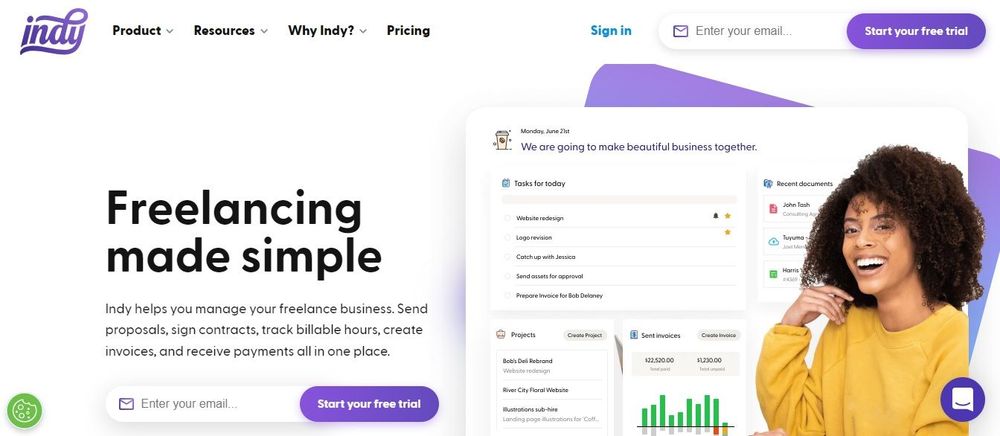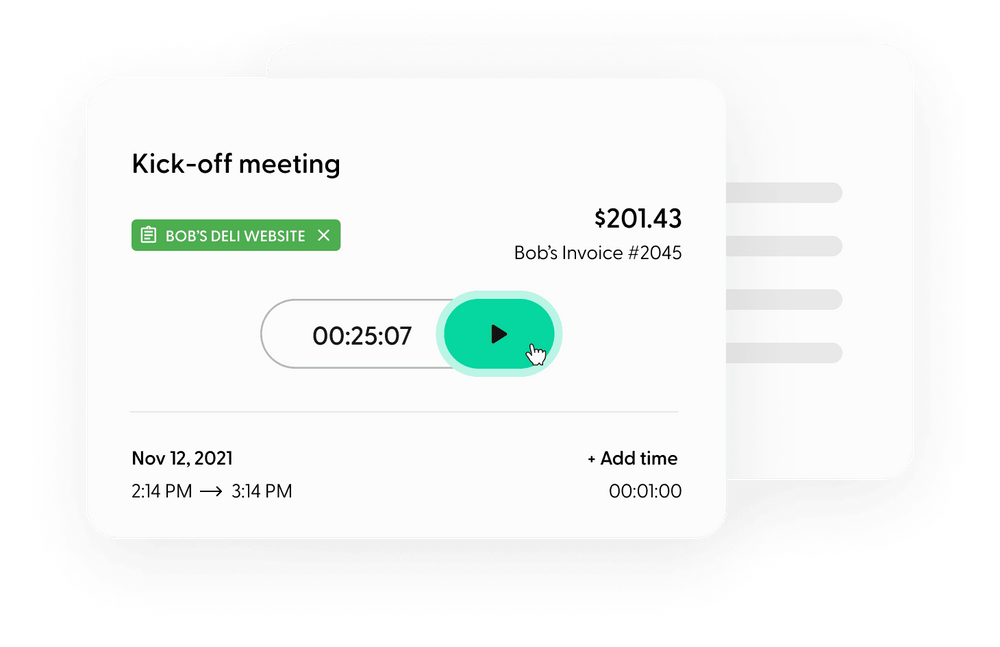Freelancers rarely want to put all their eggs in one basket, so they usually work for several clients. However, managing tasks and projects can become a problem as your freelance business grows.
You can fail to get your tasks completed if you’ve got too much to keep track of. Missed assignments lead to missed deadlines—and unhappy clients.
Keeping on top of everything is one of the essential skills a freelancer can master. Better project and task management help you:
- plan your time better
- deliver work by the deadline
- avoid becoming overwhelmed
- keep your clients happy
But if you have several clients and multiple daily tasks to keep on top of, how should you manage them?
Here we look at the importance of managing tasks and provide you with some valuable tips to get you started.
Why is task management important?
Task management is essential in nearly every job role. But for freelancers, it’s crucial.
The thing about freelancers is that they do a bit of everything. For example, if you’re a freelance designer, you don’t just do design work for your clients. You also:
- market your services
- pitch for work
- send invoices
- manage your accounts
- file your taxes
A freelancer wears many hats. Throw in the fact that you may have ten or more clients you are working with simultaneously, and things can quickly get hectic.
When you have a lot of things on at the same time, there is more risk of something going wrong. You have to be on top of your game as a freelancer. However, when you miss important details, deadlines get missed, and work does not meet expectations.
And when that happens, it’s not a telling-off from your boss that you have to worry about, as would be the case if you were in employment.
It’s far worse than that—you could lose a client.
That means less money coming in. With bills to pay, rent or mortgage payments due, and all kinds of other expenses that can be serious.
While mistakes will always happen, it’s essential to reduce them as much as possible as a freelancer to meet your deadlines, provide high-quality work, and keep your clients happy so they continue to give you more work.
As such, improving your task management should be considered an essential task for any freelancer.
Get the basics right
Before we get into the more practical tips, there are a few crucial areas to focus on. Get these right, and you’ll be well on your way to managing your projects effectively.
Set up the right working environment
Effective task management is all about being organized, and good organization starts with setting up your working environment properly. Not just your physical working environment but your online environment.
A messy desk covered with papers and notes, a cluttered inbox, and working late nights and early mornings are recipes for disaster.
Tidy up your desk
Start by tidying up your desk area. A clean and tidy working environment is one of the most straightforward organizational techniques to get you in the right frame of mind to work.

Get rid of distractions
It’s hard to work on anything when you are constantly being distracted. If you have young children, that may mean getting out of the house and working in the local cafe or a garden office, at least for a few hours.
But it’s not just your physical working environment that matters: distractions are everywhere for freelancers. Endlessly checking your emails and social media feeds will seriously affect your productivity.
Try to put some time aside each day to focus on answering emails and checking your Twitter feed rather than constantly checking them.
Get into a routine
You don’t have to work a 9-to-5 if you don’t want to. After all, setting your hours is one of the joys of freelancing. But working at odd hours in the morning and at night is never the best recipe for success.
Self-discipline is essential for freelancers, and that means planning (and sticking to) a schedule that works for you.
That might mean starting work at 5 am and finishing at midday, or starting after lunch and working until night. It depends on your lifestyle and what works for you.
Once you have a schedule in place, stick to it—you’ll find it helps you focus on your tasks more effectively.
Don’t take on more than you can chew
Before we even get to managing your tasks, it’s essential to keep one crucial thing in mind: don’t take on more work than you can handle.
If you take on too much, you risk being unable to complete your tasks to the best of your ability, if at all.
This is not always easy to do. The feast or famine lifestyle of many freelancers means it can be hard to turn down work. Sometimes, it can seem impossible.
You may never want to go back there if you’ve been through the ‘famine’ before. Even working all night is better than having no work at all.
But be careful.
This is a surefire recipe for taking on too much and ending up suffering from burnout. It’s also easier to do when you’re starting out because you may want to avoid upsetting clients by telling them you cannot take on more work.
But this is the wrong way to think about it.
Turning down work is part of the job, and it’s a skill you need to learn. There is a limit to how much you can do, and you need to be aware of that limit. When you start to manage your tasks correctly, you will better understand how long specific tasks take you and how much you can reasonably take on in the future.
It can even work in your favor.
By showing clients that you are too busy to take on a project, you’re showing them that you are a successful, in-demand freelancer. That’s a good thing.
To sum up, know what you can realistically take on, learn when to say no, and don’t be afraid to do so.
Manage client expectations
Following on from the last point, when you agree to take on a project, make sure you are very clear with the client from the start to manage their expectations.
You’ve probably got clients who want everything completed yesterday. But part of the freelance lifestyle is making it clear when that is not possible. As you get more experienced, you will work out how long it takes to complete specific tasks, how much time you will need to make revisions, and when you can realistically complete the project.
Use this information to set your deadlines. If you are unsure, be on the safe side and set a deadline for a few days longer than you think it will take. Clients are always happy to receive work early rather than late.
The key here is to be realistic. Reasonable clients will understand. And if they don’t, then perhaps they are not worth having as clients in the first place.
Practical tips for managing tasks
Now that we’ve been over the basics, it’s time to go over some practical ways to manage tasks efficiently.
Plan your breaks
There is one word that nearly all freelancers will be familiar with: burnout.
If you do too much for any period, burnout can hit. You lose focus, lose enthusiasm for the task, and do not get the work done on time.
Sitting down and working for eight hours straight is not feasible for most people. Instead, you should build breaks into your working day. Instead of doing everything in one go, focus on a task for a certain amount of time and then have a break.
It could be just a few minutes or as much as you think you need. Give yourself some time to think about something else and take your mind off the task.
There is a technique that many people use called the Pomodoro Technique. This is where you set a short period—usually about 25 minutes or so—and set a timer. When the timer goes off, you stop work, take five minutes off, and then get back to it. It’s a great way to maintain focus, and many freelancers swear by it. Try it yourself.
Don’t forget to escape from the office as well. Go and make a cup of tea, enjoy a change of scenery, get out into the garden, or go for a walk. These are all great ways to reduce the risk of burnout.
You won’t get any tasks done if you don’t look after yourself and your health. As well as getting enough breaks, make sure you work healthily. That means sitting on an ergonomic chair, eating a healthy diet, and exercising regularly. These are all things that will help you to be more productive.

Break everything down into smaller tasks
There is no worse feeling than starting your working day by sitting down at your desk and feeling overwhelmed by the amount of work you have to do. But this can quickly happen.
A project can be large—sometimes to the point where it looks overwhelming. But it is usually comprised of several separate tasks. An easy solution is to break down your projects into smaller tasks.
For example, a freelance writer may have a large writing task. It might seem daunting, but it can be broken down into:
- Research
- Planning
- Creating notes
- Writing the first draft
- Editing
- Proofreading
You may know that you need 50 percent of the total time to spend on writing while only five percent on proofreading so you can plan out the project more efficiently.
Whatever tasks you have to complete during the day, take them one at a time. While freelancers naturally have to multitask in the sense that they have more than one thing to do (marketing, sales, etc.), you don’t have to do them all simultaneously.
Take it one task at a time
Multitasking is a bit of a con. It makes you feel like you are doing more and being more productive when the opposite is true. It reduces the amount of energy you dedicate to each task, and you spread your energy too thin.
In the end, you don’t do the job to the highest standard, and you get exhausted and stressed.
Divide up your tasks for the day, and always try to work on one at a time, either for a set period or until it is complete.
Working on a large project can feel like it’s never getting to the end and that you’re not getting anything done even when you are. This can be dismaying and put you off or even make you feel like giving up. This helps by giving you a sense of progress.
But when you can cross off a task, you can see your progress and how much you have achieved, which helps to keep you motivated.
Plan your daily & weekly tasks
So, now you are focusing on one task at a time, there’s another big issue. Which job should you work on first? This is where the benefit of a plan comes into play.
It’s a good idea to plan out your projects and tasks at the beginning of the week and then plan your separate tasks at the start of each day.
Even spending five minutes on this can help give structure to your day and give you a good idea of how long it will take you to complete all your work. You could even break it up into morning and afternoon tasks.
It’s easy to mismanage your time and work on one task for too long, then get to the end of the day and realize you haven’t finished your work.
By doing this, you can prioritize your tasks. You could even change their order around to start your day with an easier task to ease you into the day. Or you might want to get all your more challenging jobs done in the morning and then spend the afternoon on more minor client-focused tasks like marketing.
Only you know what works best for your situation, but having some plan is a great idea.
Create a to-do list
While the idea of planning the tasks for your week and day may seem straightforward, there are lots of different ways you can do this. This is where task management comes into play.
At its most basic, you should have a to-do list.
To-do lists work for many freelancers. People have used them for decades, and they are still highly effective. Simply write out your tasks for the day or days ahead on paper, and then cross them off when you complete them.
You could do the same on your computer, perhaps in Evernote or somewhere else in the cloud where you can access it from anywhere.
You could keep it simple or use a tool that allows you to use color-coding and collaboration features with clients or other team members in a project.

Use a task management tool
To-do lists are all well and good, but the modern freelancer often needs more than a simple list. This is where task management tools come into the picture.
Project managers often use software to help them, and freelancers can use it too. The best task management tools allow you to get through multiple projects, organize tasks, and manage them more effectively. That way, you can work out how long each task will take and stay on top of your workload without getting stressed.
There are lots of tools out there. Some are more complex than others, and they come with different features.
A sound task management system provides you with a place to manage all your tasks in one place and prioritize tasks. They are often in the cloud, so you can access everything you need from anywhere, and they come with collaboration tools, either for working with clients or when you assign tasks to other team members.
You might not need all the tools, but you can usually personalize your task management tool to make it work. Everyone has different processes and ways of working. You need a task management app that is adaptable to your needs.
This may mean using a more visual tool to see which tasks are due and when. You may be able to drag and drop tasks rather than crossing them off.
Whichever tool you use, quality task management software can significantly impact your ability to get things done.
Streamline communication
Always prioritize communication with your clients. If you are unable to meet a deadline, let them know as soon as possible. Most clients will be reasonable and understanding if something comes up and you need to push it back a few days. But they will be less understanding if the deadline arrives and, instead of finding a completed project in their inbox, they find an excuse from you.
Communication is essential for freelancers. Tasks do have to get moved around sometimes. Perhaps a client has a rush order that just can’t wait, and you have to push some work back a day or two.
But always tell your clients as soon as possible. Keep them up to date on how a project is progressing, and let them know about any potential problems you foresee or any need to change deadlines.
Clients love freelancers who communicate well. They are trusting you to do a good job, and they are paying you good money to do it, so giving them regular updates is important. It can also help defuse potentially serious situations if you are going to miss a deadline.
The problem for many freelancers is that communication is not always easy. If you have 20 clients and a similar number of projects, sending emails back and forth can cause serious problems.
Information gets lost, deadlines get missed, and we’re back to the key problem of upsetting your clients.
Look into other tools that streamline communication and get messages out of your inboxes. There are lots of tools available these days that make it easy to chat with clients and teams in a single place rather than messing around with endless emails, so find one that works for you.
Become a clockwatcher
Time management is essential. There is nothing worse than getting involved in a task and ending up spending a whole morning on it only to remember too late that you have ten other tasks to complete.
As a freelancer, you have to become a clockwatcher. We’ve already touched on this topic with the Pomodoro technique, but there are two areas to focus on here.
It’s really important to know how long a task is likely to take you, and then you can plan your day around tasks based on this time estimate.
This is easier to do as you get more familiar with your tasks because you will have a clearer idea of how long it takes to come up with the first draft of an advertising brochure or design a logo.
One thing that can really help is timing yourself, and there are lots of time trackers out there for this that you can run on your computer and track the amount of time it takes to work on a particular task.
This can be really helpful when you are still new to freelancing. Even if you are not getting paid by the hour, it’s important to know what your time is worth. If you want to be earning a certain amount for every hour you work, you should know how many hours a task or project takes and charge accordingly.
Time trackers can be very revealing. You may find out at the end of the week that you spent far longer on a task than you planned to, and you can change your pricing as a result.
But it also gives you a good idea of when to move on to the next task. If you have spent an hour on a job and that’s all you have given yourself on that day before moving on, a timer can help you to stop and move on to the next task. That way, you don’t get too caught up in it and end up rushing the rest of your tasks for the day.
Schedule tasks in a calendar
It’s also a great idea to schedule your tasks in some way. The easiest way to do this is using a calendar.
Online calendars like Google Calendar sync over the cloud to all your devices, and there are lots of features that make scheduling deadlines, meetings, and other important tasks easy.
Get into the habit of keeping a schedule, and you can quickly see whether you have space to take on more work if you are asked.
You can also use a calendar to set reminders. That way, if you have an important project due the next day, set a reminder the day before. When you have dozens of tasks to do every week, this can help to prevent you from missing things.
This can be especially useful for smaller tasks, including things like getting in touch with a client to find out if they have any projects or following up to get feedback, which could otherwise be missed.
Share access to your documents
If you are in a team, it goes without saying that you should share your documents so you can work on them together and collaborate more effectively, saving time with all the unnecessary back and forth.
But even if you work alone, it’s a good idea to share documents with your clients to improve collaboration.
You could do this in Google Drive by creating a new shared folder for each project and sharing it with your client, then uploading all the information there. If you keep everything in one place, you won’t waste time searching for documents, designs, and invoices.
Find ways to ‘cheat’
Sometimes all the tasks you have to do can seem overwhelming. Do you find your time is taken up with small, mundane tasks that you wish you didn’t have to do? Things that take up hours of your day but are boring and repetitive?
This is a classic problem for freelancers.
Fortunately, we live in an age of automation. There are now many tasks that can now be automated, freeing up your time to spend on more important things.
For example, you could create several email templates to save yourself the time it takes to come up with new emails from scratch. You could create email templates for prospecting clients to respond to requests for samples, send information about your rates, follow up for feedback, send invoices, follow up payments, and more.
There are other tools that you can use to create proposals quickly and then convert the proposal into a contract and even an invoice to save time on each stage of the process.
If you can’t automate, consider outsourcing. All those little administrative tasks that take up your time? It could work out for you to outsource them to another freelancer who specializes in such tasks and can do them quicker. If they charge less than you charge your own clients, it could work out in your favor and help you to scale up your business.
Use an all-in-one platform
All of the above are great ways to manage your tasks and projects more efficiently. But you don’t always need separate tools for each area.

Rather than using one tool for timing your work, one for sharing docs, one for creating invoices, etc., consider using one online task management tool that does it all.
Indy is an all-in-one project management software platform for freelancers that combines all of these and more in one simple place.
It includes:
- Tasks
- Calendar
- Chat
- Contracts
- Time Tracker
- Files
- Invoices
- Forms
- Proposals
It’s designed to be used as a complete online task management software solution for freelancers, providing you with everything you need to manage a freelance business and helping to free up your time to focus on your work.
Conclusion
Many freelancers can never see themselves working for someone else once they have given it a go. But despite all the benefits, it certainly has its challenges.
Staying on top of tasks and projects is one of the most essential skills to master as a freelancer. By using WeAreIndy, you can enjoy a huge suite of tools that can help you master your task management.
So get organized, get your tasks under control, and enjoy running a successful freelance business.



